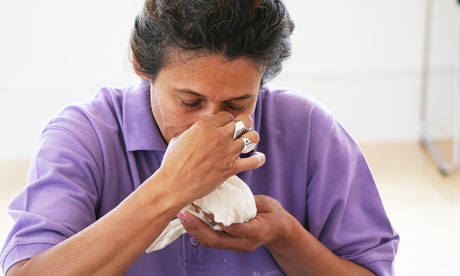Researchers document the use of pork strips for treating nosebleeds

Stop those troublesome nosebleeds with strips of cured pork! Photograph: St John's Ambulance
A new medical study recommends a method called "nasal packing with strips of cured pork" as an effective way to treat uncontrollable nosebleeds.
Ian
Humphreys, Sonal Saraiya, Walter Belenky and James Dworkin, at Detroit
Medical Centre in Michigan, treated a girl who had a rare hereditary
disorder that brings prolongued bleeding. Publishing in the Annals of
Otology, Rhinology and Laryngology, they pack the essential details into
two sentences:
"Cured salted pork crafted as a nasal tampon and
packed within the nasal vaults successfully stopped nasal hemorrhage
promptly, effectively, and without sequelae … To our knowledge, this
represents the first description of nasal packing with strips of cured
pork for treatment of life-threatening hemorrhage in a patient with
Glanzmann thrombasthenia."
They acknowledge a long tradition of
using pork to treat general epistaxis, ie nosebleed. The technique fell
into disuse, they speculate, because "packing with salt pork was fraught
with bacterial and parasitic complications. As newer synthetic
hemostatic agents and surgical techniques evolved, the use of packing
with salt pork diminished."
In 1976, Dr Jan Weisberg of Great
Lakes, Illinois wrote a letter to the journal Archives of
Otolaryngology, bragging that he, together with a Dr Strother and a Dr
Newton, had been "privileged" to treat a man "for epistaxis secondary to
Rendu-Osler-Weber disease", an inherited problem in which blood vessels develop abnormally.
In 1953, Dr Henry Beinfield in Brooklyn, New York, published a treatise called General Principles in Treatment of Nasal Haemorrhage.
Beinfield explains: "Salt pork placed in the nose and allowed to remain
there for about five days has been used, but the method is rather
old-fashioned."
In 1940, Dr AJ Cone of the Washington University School of Medicine, in St Louis, praised the method in a paper called Use of Salt Pork in Cases of Haemorrhage.
In Dr Cone's experience, "it has not been uncommon in the St Louis
Children's Hospital service to have a child request that salt pork be
inserted in his nose with the first sign of a nosebleed … Wedges of salt
pork have saved a great deal of time and energy when used in
controlling nasal haemorrhage, as seen in cases of leukemia, haemophilia
... hypertension ... measles or typhoid fever and during the third
stage of labour".
0 comments:
Post a Comment